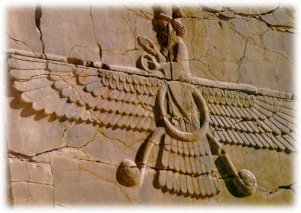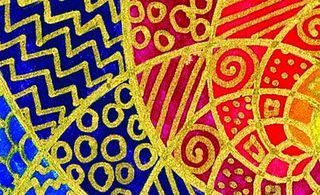Wednesday, July 27, 2005
Monday, July 25, 2005
روحانیت یا معنویت از نظر مهرباباMehrBaba on SPIRITUALISM
Jay Jay Mehr Babaزنده باد مهر بابا

Tuesday, July 19, 2005
Drunkenly along the Sufi Path of Love, misc....!
18 spiritual couplets and 18 selected ghazals
by
Molana Jalaleddin Rumi Balkhi
followed by
a brief life of Rumi, glimpses of his masterpiece, the Masnavi,
and a sketch of the life of Shams
interwoven with
meditative mandalas
Mohsen Khatami & Prem Shashi
Acknowledgments
With special gratitude and appreciation to:
Arya Khatami, without whose patience, good will and computer-related expertise
Thanks also to Muslim Poonawala, Swami Deva Urja,
for their advice, help and support along the way....
Dedication
We offer this ‘carpet’
to all seekers of truth - which is nothing but love.
We hope this collection can assist you on your journey,
and we would be delighted to hear any stories
about your ‘flights’ with this ‘carpet’!
Love and light
Mohsen Khatami Ma Prem Shashi
Pune, India, May 2004
Table of contents
Acknowledgments 4
Introduction by Mohsen Khatami
This magic carpet 9
Introduction by Prem Shashi
These magic circles 13
General introduction
A taste of Sufism 17
18 Masnavi couplets and 18 ghazals
1 With ego, without ego 23
2 The Beloved is coming 29
3 Hearts like whales 33
4 That house and this house 37
5 How can I be a man? 41
6 Pour the wine 47
7 The hidden treasure 51
8 Birds who have flown 57
9 Become a myth, become a myth 61
10 Wine of love 67
11 Die, die in this love 71
12 Dancing from nothingness into being 75
13 The spring of my Lord 79
14 Circle of lovers 83
15 Breaking free 87
16 How drunk we are! 91
17 Love and reason 95
18 Divine physicians 99
Life of Rumi
From the love of wisdom to the wisdom of love 103
A glimpse at Rumi’s masterpiece
An ocean of Sufi wine: the Masnavi 125
Fragments from the life of Shams
Sun of truth and mystical midwife 135
Footnotes for the spiritual couplets and ghazals 153
Index of Sufi concepts 182
References 183
Mandala titles and details 184
This magic carpet
Look at me! Look at me! I’ve come back to take away your sadness;
I return full of joy, I return full of joy - I return free from everything - Rumi
Like every Persian, I first encountered Rumi’s verse in my school days,
It was not until many years later that I came across Rumi once more,
But the turning point came in 1991, when I began reading the works of ‘Molana’ Osho.
About two years ago I was contemplating translating a few selected poems by Rumi,
Meeting the beautiful soul Prem Shashi a few months later was a definite sign
This book is the result of many magical moments we spent together,
As our beloved Rumi says: “Do not see us with the eyes in your head,
I am truly grateful to my beloved collaborator for contributing her dazzling mandalas,
I hope you will enjoy absorbing the essence of the Sufi message
Be blissful.
Mohsen Khatami
Pune, India, May 2004
These magic circles
When Mohsen suggested this book project to me,
For, in my life in India, when I am not painting mandalas (or editing works on Rumi),
When I am whirling, I often feel myself to be quite still at the centre of the vortex
When I am working on the mandalas I find the disciplines of the intricate and regularly repeating design, held within a circle, and the practice of always working
an insight with which no Sufi could disagree.
This contemplation is the true function of the mandala: it serves as an aid to meditation,
So I accepted Mohsen’s invitation, and have greatly enjoyed working -
There is another connection between my mandalas and Persian carpets.
Choosing a mandala for each ghazal was a wholly intuitive process -
Enjoy.
Prem Shashi shashimandalas@yahoo.co.uk
Pune, India, May 2004 www.premshashimandalagallery.com
A taste of Sufism
This selection is a brief dive into the vast ocean that is Molana Jalaleddin Rumi.
There are many different ways to define Sufism - some scholarly, some historic,
The Path of Love, as it is also called, is in fact the esoteric face of Islam,
Sufi teachings and practices are traditionally transmitted directly from a master
Osho has described his own sannyasins as “the Sufis of the new age”, and emphasises
And if you would like to understand the essence of Sufism,
“A Sufi need not be a Mohammedan. A Sufi can exist anywhere, in any form -
“Whenever a religion is alive it is because of Sufism. Sufism means a love affair with God,
Osho - Sufis: The People of the Path, Vol 1
The warp and the weft of this work
The content of this book is designed and presented in a slightly idiosyncratic manner.
The couplets of the Masnavi are presented in three ‘languages’: the original Farsi,
Where the style of the translations is concerned, we have kept it as literal as possible,
Following the series of 18 couplets and ghazals, is a chapter on the life of Rumi,
An alternative way to fly this carpet
Many great spiritual books are popularly used for divination.
Gurupurnima, fullmoon2005 ch 18 Drunkenly...Sufi...
Divine physicians
We are wise men, we are physicians,
we come from Baghdad;2
we have delivered many patients from their sorrows.
We have removed cataracts from their eyes;
and the meaningless, endless sufferings
from their roots and veins with grapples.
We are the eloquent physicians - disciples of Christ;
we have taken many dead ones
and breathed spirit into them.3
Ask those who have seen the signs
to tell you how thankful they were for their freedom.
We batter the head of sadness,
we sweep pain out of the home;
we are all witnesses and good people -
we are all like new moons, bringing tidings of the Eid.4
We are divine physicians;
we do not ask wages from anyone,
because we are pure in psyche -
not greedy and dirty.
Do not think that this is a medicine
for diarrhoea or constipation;
we have extracted this famous herbal cure from paradise.5
We are subtle physicians -
we do not take urine samples;
we penetrate aching bodies as thought waves.
Do not open your mouth at all,
since most people are like owls;6
stop bragging that we have flown with the eagle.7
1) In this, the 18th couplet of the Masnavi, Rumi states that there are two types of people: “raw”, or spiritually undeveloped, and “cooked” - those who are spiritually evolved. Since the former are not capable of understanding the condition of the latter, there is no point in arguing, and the best approach to such “raw” individuals is to remain silent. “Vassalam”, meaning “and peace”, is used to end abruptly any speech or conversation.
2) See footnote 5, p163. In this ghazal, Rumi depicts himself as a doctor with a miraculous cure for all ills.
3) In Sufi tradition, Christ is well known for his healing powers, and specifically for his ability to raise the dead.
4) The ending of the lunar month of Ramadan (the month of fasting) is the greatest celebration in the Muslim calendar, and known as the Eid.
5) Here, in the original Farsi, Rumi names two specific herbal medicines for these two common physical disorders.
In contrast with these, the kind of medicine he is offering has been extracted directly from heaven and is a cure for all spiritual ills.
6) In Persian folklore, the owl is a bad omen, associated with ill luck. Interestingly, whereas in western tradition, the bird is a symbol of wisdom, in India, it is believed to be stupid.
7) In Sufi terminology, to “fly with the eagle” is to attain the peak of human consciousness, or to live in divinity.
Buddha's The Noble Eightfold Path
Buddha's words of compassion
The Buddha's words of compassion:
Don't accept something:
چیزی را قبول نکن چون
آن را بارها شنیده ای
یا که بطور سنتی برای قرن ها باور داشته شده است
یا که تعداد خیلی زیادی از مردم آن را باور دارند؛
و یا اینکه مطابق با کتاب مقدس تو است؛
یا چون منطقی به نظر میاید؛
و یا که در خط باورهای تو است
و یا چون توسط آموزگاری اظهار شده که شخصیت جذابی داشته و مورد احترام زیاد تو است.
فقط وقتی بپذیر که خودت در سطح تجربی آن را دریافته باشی و آن را برای خودت و همگان خوب و مفید یافته باشی.
پونا : آبان ماه 1383
Vipassana = wittnessing = Buddha meditation
VIPASSANA WEBSITESD
hamma Giri: www.vri.dhamma.org
Contains information about Indian Vipassana centres and Schedule of Courses, VRI Newsletters, VRI publications, research papers about Vipassana, etc.
Vipassana (introduction):
Contains information about Goenkaji, Course Schedules of Vipassana centres worldwide, Code of Discipline, Application Form for ten-day courses, etc.
Vipassana (old students only): www.dhamma.org/os
Contains information for old students of Vipassana including International Vipassana Newsletters and reference material. (username: oldstudent; password: behappy)
Pali Tipitaka Website: http://www.tipitaka.org
Contains the Chattha Sangayana Tipitaka in Roman script with commentaries, sub-commentaries and related Pali texts.Ownership of Vipassana Newsletter and other information
Name of the newletter: Vipassana NewsletterLanguage:
EnglishFrequency of publication: Monthly (every Purnima)Place of Publication:
Vipassana Research Institute,Dhamma Giri, Igatpuri-422403Name of the printer,publisher and editor: Mr Ram Pratap YadavNationality: IndianPlace of printing: Akshar Chitra, B-69, Satpur, Nashik-422007
Name of the proprietor: Vipassana Research Institute Registered Main Office: Green House, Second floor, Green Street, Fort, Mumbai-400023I, Ram Pratap Yadav, declare that the above-mentioned information is true to the best of my knowledge.
Ram Pratap Yadav3 March 2003 Printer, Publisher and EditorNEW RESPONSIBILITIESAcaryas:1. & 2. Prof. Pyare Lal & Mrs. Sushila DharAT Training, To serve Bhutan, Dhamma Tihar and Dhamma Rakkhaka, Research for jail courses, police courses etc.3. & 4. Mr. Vishwambhar & Mrs. Nalini DahatTo serve Vidarbha except Dhamma Naga5. Mr. N. Y. LokhandeSpread of Dhamma6. Mrs. Jaya ModiSpread of Dhamma7. & 8. Dr. Geo & Mrs. Cathy PolandSpread of DhammaSenior Assistant Teachers1. Mr. Dinesh MeshramTo serve Dhamma Kanana2. & 3. Mr. Sureshchandra & Mrs. Kanta KathaneTo serve Dhamma Ketu4. & 5. Mr. Gopal Sharan & Mrs. Pushpa SinghTo serve Dhamma Lakkhana6. & 7. Mr. Mark & Mrs. Petra LennonNEW APPOINTMENTSAssistant Teachers1. & 2. Dr. Sharad & Dr (Mrs.) Pushplata Badole, Bhilai3. Mr. Kailashchand Bagdiya, Raipur4. & 5. Mr. Guy & Mrs. Tamar Gelbgisser, Israel6. Mr. Guy Hertzog, Israel 7. Mrs. Ann Aston, U.K.
در حصار پوست CagedintheShell
اي خداوند كلام معنوي!
خالق حق واژه هاي مثنوي!
شمس را ديدي و شمس ما شدي:
مولوي بودي و مولانا شدي!
هدهد ملك سليماني! بيا! قاصد پيغام جاناني، بيا!
ناي جانت خوش حكايت مي كند
قصه ي ما را روايت مي كند
چون كه از هجران حق نالان شدي
"جفت بدحالان و خوشحالان شدي"
بانگ حق را چون ز جان بشنوده اي
دفتري از سر حق بگشوده اي
اي نشسته بر پر جبرييل عشق
وي دميده صور اسرافيل عشق
خيز و برخوان قصه ي بود و نبود
آتش افكن در نيستان وجود
فخر عرفاني و سلطان وفا
در سرودت، سر دين مصطفا
مثنوي تو، براق جان ما
بيت بيتش پله ي عرفان ما
جاي تو خالي است، اي پيغام عشق!
تا بنوشاني به جان ها، جام عشق!
قلب هامان ساغر خالي شده است
عشق ها، رنگين و پوشالي شده است
"عشق هايي كه از پي رنگي بود،
عشق نبود عاقبت ننگي بود"
چون جدا گشتيم از پيغام عشق
هيچ نشناسيم ما، جز نام عشق
تو ز قرآن مغز را برداشتي
پوست را بر جاهلان بگذاشتي!
وه كه ناگه از هجوم جهل دوست
جا به جا شد جايگاه مغز و پوست!
بشنو از من تا حكايت ها كنم
زين جنايت ها، شكايت ها كنم!
ما ز قرآن قهر را برداشتيم
مهر را بر ديگران بگذاشتيم!
آيه هاي مهر قرآن كم شدند!
سينه ها: نفرتگه مردم شدند!
پوستين وارونه پوشيديم ما!
در مسير قهر كوشيديم ما!
از اذان عشق دور افتاده ايم
چون خميري در تنور افتاده ايم!
آيه هاي عشق زنداني شدند!
عارفان، بي جرم قرباني شدند!
حافظ آيات قرآني شديم!
در حصار پوست، زنداني شديم!
حافظ قرآن! ولي خالي ز نور:
از عروج دل به عرش عشق، دور!
قبله ي ما، بار ديگر سنگ شد
بي حضور عشق، حج، نيرنگ شد!
چون مجال عاشقي ها تنگ شد
"موسيي با موسيي در جنگ شد"
بوستان، منزلگه بلبل نشد
بي محبت، خارهامان گل نشد!
حكم كفر عاشقان را داده اند!
دارها بر عاشقان بنهاده اند
هر شباني را كه ديدندي به راه:
"كو همي گفت اي خدا و اي اله"
"تو كجايي تا شوم من چاكرت؟
چارقت دوزم، كنم شانه سرت؟"
چوب تكفيرش بسي بر سر زدند
وز تعصب، بر دلش خنجر زدند!
تا نيايد بر لب كس يك دعا
خارج از دستور شيخ شهر ما!
فقه را بر دين تقدم داده اند
وعده ي جنت به مردم داده اند!
عشق را كشتند، تا دين پرورند!
وز صراط جاهلان خوش بگذرند!
ذكر را ورد زبان دانشته اند!
مكتب آه و فغان دانسته اند!
لذت ذكر خدا از ياد رفت!
شور و شوق "ربنا" از ياد رفت!
ليلي و مجنون كجا و دين كجا؟
حسرت آن خسروي شيرين كجا؟
هيچكس آيات رحمت را نخواند
مركبي تا خانه ي دل ها نراند
قلب هامان خون شد و پر سوز شد
روزهامان بدتر از ديروز شد!
هان! نگويم شرح غم را بيش از اين
به كه كوته آيد اين بانگ حزين!
"كاشكي هستي زباني داشتي
تا ز هستان پرده بر مي داشتي!"
كاش مي پيچيد در گوش زمان
نغمه اي چون نغمه ات، اي ناي جان!
تشنه ي يك مثنوي ديگريم
دست كم، ما درخور يك دفتريم!
شمس قرن تار ما گر مي شدي
قرن ما، قرني منور مي شدي!
قرن عشق و قرن عرفان: قرن نور
قرن "اميد" و صفا: قرن شعور!
اميد: تهران آذرماه 1381
Lovebloging
“Warblogger Veteran weblogger Dave Winer defines a warblogger thus:
"A warblogger is a person who runs a weblog that started around, or was significantly influenced by the events of September 11 2001,
" which is as good a definition as we've found.
The best known warbloggers are Glenn Reynolds
of Instapundit.com and Andrew Sullivan. “
…..from weblog glossary
they even give their lives for their profession,
mohsen khatami
http://www.iran-pen.org/english/members.html
Four agreements for personal freedomچهار توافق برای آزادی فردی
4 agreements
چهار توافق برای آزادی فردی
1. No sin with your words
2. Do not take everything to yourself
3. Do not live in delusion
4. Do your best.
بهترین تلاشت را بکن
Monday, July 18, 2005
is 'supposed to be' NEW
So, please forgive if it is not the 'sameoldstuff'!
New friends and colleagues are welcomes to join and share.
آنچه اینجا بایگانی می شود
قرار است "تازه" باشد
پس لطفاٌ ببخشید اگر همان چیزهای کهنه نیستند!
از حضور دوستان تازه و همکاران جدید استقبال می شود


















































